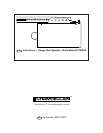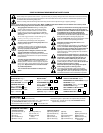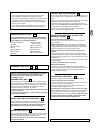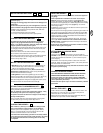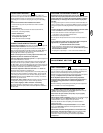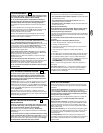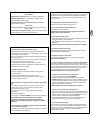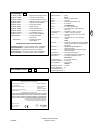
OPERATION OF YOUR OPENER
Your opener can be activated by any of the following devices:
• The Lighted Door Control Button (optional). Hold the button down
until door starts to move.
• The Outside Keylock or Keyless Entry System (if you have
installed either of these accessories).
• The Remote Control Transmitter. Hold the push button down until
the door starts to move.
Opening the Door Manually:
Door should be fully closed if possible. Weak or broken springs
could allow an open door to fall rapidly. Property damage or
serious personal injury could result.
The door can be opened manually by pulling the release handle down
and back (toward the opener). To reconnect the door, pull the release
handle straight down.
Do not use the manual release handle to pull the door open
or closed.
When the Opener is Activated by Remote Control:
1. If open, the door will close. If closed, the door will open.
2. If closing, the door will reverse.
3. If opening, the door will stop (allowing space for entry and exit of
pets and for fresh air).
4. If the door has been stopped in a partially open position, it
will close.
5. If an obstruction is encountered while closing, the door will reverse.
6. If an obstruction is encountered while opening, the door will stop.
7. The optional Protector System™ uses an invisible beam which,
when broken by an obstruction, causes a closing door to open and
prevents an open door from closing. It is STRONGLY
RECOMMENDED for homeowners with young children.
Allow a 15 minute cooling period after 5 continuous operations of
the opener.
The opener light will turn on: 1. when opener is initially plugged in;
2. when the power is interrupted; 3. when the opener is activated.
The light turns off automatically after 4-1/2 minutes. Bulb size is
40 Watts maximum, ESRS type.
TEST THE SAFETY REVERSE SYSTEM –
The safety reverse system test is important. Garage door must
reverse on contact with a 25mm (1") obstacle laid flat on the
floor. Failure to properly adjust opener may result in serious
personal injury from a closing garage door. Repeat test once a
month and adjust as needed.
Procedure: Place a 25mm (1") obstacle (1) laid flat on the floor under
the garage door. Operate the door in the down direction. The door
must reverse on the obstruction. If the door stops on the obstruction,
it is not traveling far enough in the down direction. Increase the down
limit by turning down limit adjustment screw counterclockwise
1/4 turn. Repeat test.
When the door reverses on the 25mm (1") obstacle, remove the
obstruction and run the opener through a complete travel cycle. Door
must not reverse in closed position. If it does, adjust Limits and Force
and repeat safety reverse test.
23
INSTALL THE PROTECTOR SYSTEM
TM
–
(See accessories)
The force, as measured on the closing edge of the door, should
not exceed 150 N (15kg). If the closing force is adjusted to more
than 150 N, the Protector System must be installed.
After opener has been installed and adjusted, The Protector
System™ accessory can be installed. Instructions are included with
this accessory.
The Protector System™ provides an additional measure of safety
against a small child being caught under a garage door. It uses an
invisible beam which, when broken by an obstruction, causes a closing
door to open and prevents an open door from closing and is strongly
recommended for homeowners with young children.
24
CARE OF YOUR OPENER
When properly installed, opener will provide high performance with
a minimum of maintenance. The opener does not require additional
lubrication.
Limit and Force Adjustments: These adjustments must be checked
and properly set when opener is installed. Only a screwdriver is
required. Weather conditions may cause some minor changes in
the door operation, requiring some re-adjustments, particularly
during the first year of operation.
Refer to the limit and force adjustments on pages 4 & 5. Follow the
instructions carefully and repeat the safety reverse test after
any adjustment.
Remote Control Transmitter: The portable remote control may be
secured to a car sun visor with the clip provided. Additional remotes
can be purchased at any time for use in all vehicles using garage.
Refer to Accessories. The receiver must be programmed to operate
with any new remote.
Remote Control Battery: The 12 Volt battery should produce power
for at least one year. When the light becomes dim or does not come
on, replace the battery. If transmission range lessens, check the
battery test light.
To Change Battery: Remove visor clip and connecting screw in
transmitter case. Snap connector onto new battery. Do not dispose of
the old battery with household waste. Take batteries to a proper
disposal center.
FORCE ADJUSTMENT –
The force, as measured on the closing edge of the door, should
not exceed 150 N (15kg). If the closing force is adjusted to more
than 150 N, the Protector System must be installed.
Do not use force adjustments to compensate for a binding or
sticking garage door. Excessive force will interfere with proper
operation of safety reverse system or damage garage door.
Force Adjustment Controls (1 & 2) are located on the back panel of
opener.
If the force adjustments are set too light, door travel may be
interrupted by nuisance reversals in down direction and stops in up
direction. Weather conditions can affect the door movement,
occasional adjustment may be needed.
Maximum force adjustment range is 260 degrees, about 3/4 of a
complete turn. Do not force controls beyond that point. Turn force
adjustment controls with a screwdriver.
Test Down (Close) Force: Grasp the door handle or door bottom
when door is about halfway through down (close) travel. Door should
reverse. (Reversal halfway through down travel does not
guarantee reversal on a 25mm (1") obstruction.) If the door is hard
to hold or doesn't reverse, decrease down (close) force by turning
the control (2) in a counterclockwise direction. Make small
adjustments until door reverses normally. After each adjustment, run
opener through a complete cycle.
If Door Doesn't Open at Least 1,5m (5 feet): Increase up (open)
force by turning the control (1) in a clockwise direction. Make small
adjustments until door opens completely. Re-adjust
up limit if necessary. After each adjustment, run opener through a
complete travel cycle.
If Door Reverses During Down (Close) Cycle: Increase down
(close) force by turning the control (2) in a clockwise direction. Make
small adjustments until door completes close cycle. After each
adjustment, run the opener through a complete travel cycle.
Do not increase the force beyond the minimum amount required
to close the door.
22
5-GB



